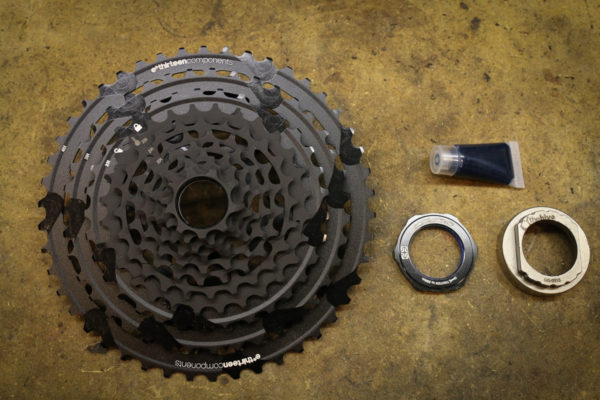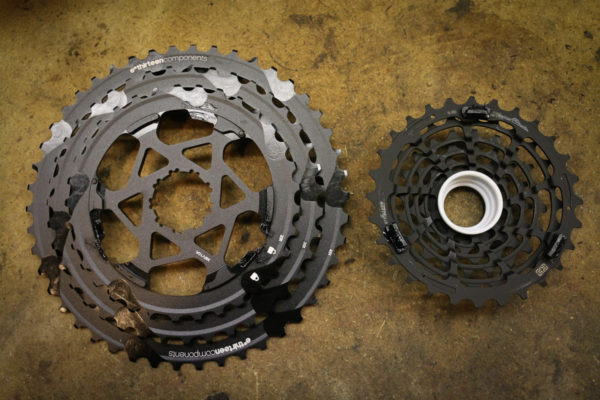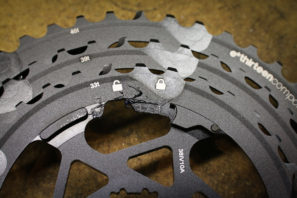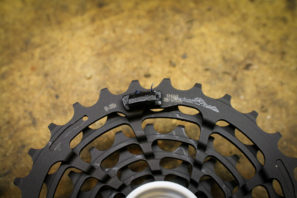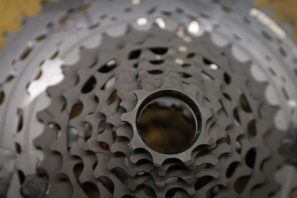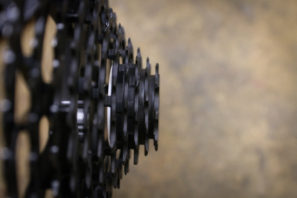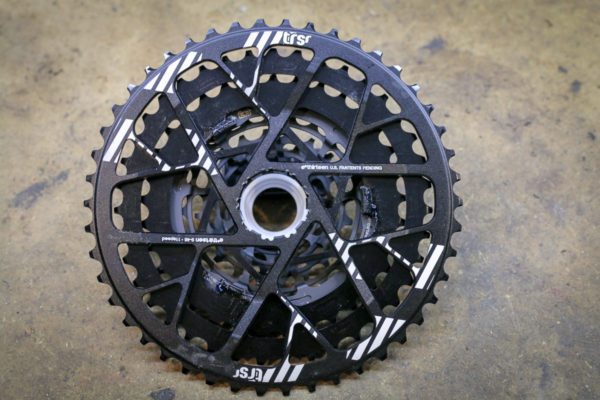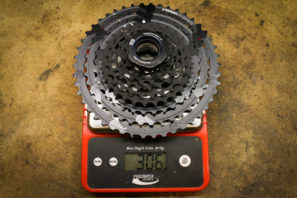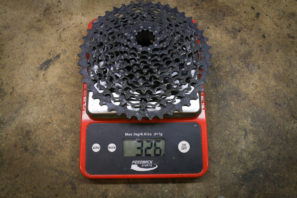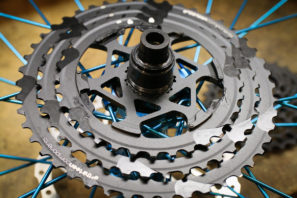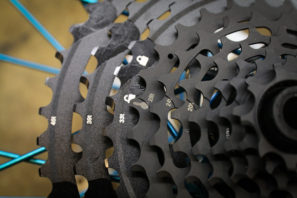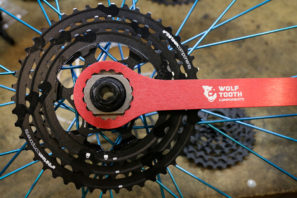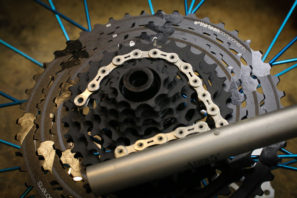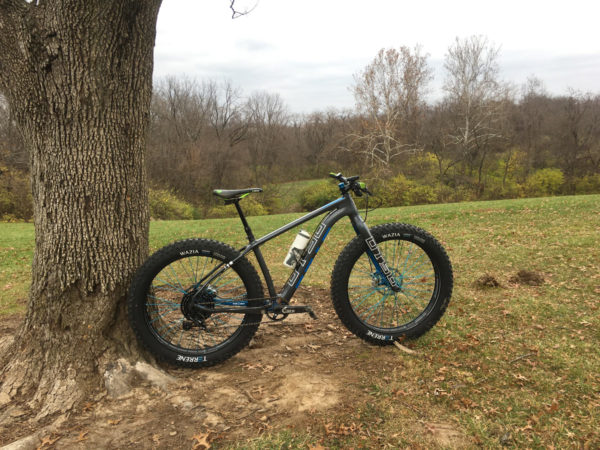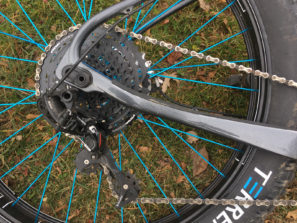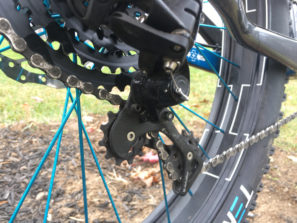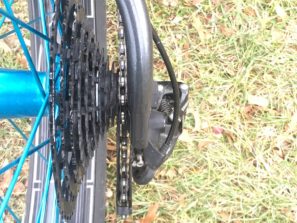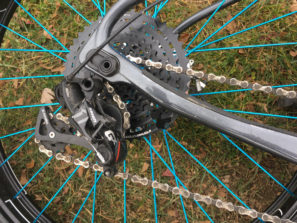More range, less weight, and fewer dollars – that’s unattainable when it comes to wide range cassettes, right? With their new TRSr cassette, e*thirteen is hoping to turn that notion on its head. Aiming straight for the new mega cog king in the form of SRAM Eagle, e*thirteen looks to have a solid contender on their hands with their newest cassette.
An evolution of their TRSr cassette construction, the steel and aluminum cassette offers an impressive range with 9-46t gearing, and an equally impressive weight and price…
Representing the most significant change to cassette design since the introduction of SRAM’s XD one piece cassettes, the e*thirteen unit uses a two piece design (three if you consider the lockring), with the largest three cogs made out of a single cluster of aluminum, and the remaining 7 made from a single block of steel. The two halves lock together with three interlocking tabs and the steel cluster twists clockwise to lock into place. To keep the shifting ramps in sequence, one of the three locking tabs is smaller and keys in at the laser etched locked/unlocked symbols. Each cassette ships with a little tube of grease to ensure the locking tabs are properly lubricated. Our cassette was already greased but you should make sure that the tabs have adequate grease each time the cassette is installed.
The smaller steel cluster is the key to the TRSr’s super range in that it allows for a 9t cog to be added. Since there is no need for a cassette lockring, the 9t cog fits on a standard XD free hub body and is machined from one piece of steel with the other cogs. Combined with the aluminum upper section, the cassette offers a 9-10-12-14-17-20-24-28-33-39-46 gearing progression that is compatible with certain SRAM and Shimano 11 speed derailleurs.
Out of curiosity, I weighed the SRAM XG-1175 10-42t cassette that swapped places with the TRSr. Considering that the SRAM cassette is fairly entry level by comparison (it’s SRAM’s cheapest 10-42 cassette with an aluminum 42t cog), it shouldn’t be a big surprise that the TRSr is lighter, but even with bigger and smaller cogs, it’s still 20g less. The most impressive part is that the cassette is 54g less than the SRAM XX1 Eagle 10-50t cassette even though the TRSr has a wider effective range (511% vs 500%). It’s also less expensive than the SRAM X01 Eagle cassette by $11 at $349.
However, the cassette is 19g heavier than the claimed 287g when weighed with lock ring.
Installation is fairly straight forward and starts by placing the aluminum cluster onto the splines on any XD free hub body. A lock ring is then placed over the aluminum cogset and is tightened with the included cassette tool which requires a Hollowtech-II style BB/Centerlock rotor wrench to tighten to 25 N*m. The lock ring comes with blue Loc Tite already applied which makes the threads pretty tight to turn, so just make sure the ring is properly engaged on the threads before you start wrenching down.
Once the aluminum section is installed, the steel cluster is placed on top with the locking tabs properly engaged so the indicator on the steel cog lines up with the ‘unlocked’ symbol on the aluminum cog. Next, just use a chain whip to grasp the steel cluster and turn it until the indicator lines up with the ‘locked’ symbol. From here the pressure from the chain on the cassette will help keep the cassette locked until you’re ready to remove it and you reverse the process with a second chain whip.
Due to the timing of the cassette showing up and needing to get some time on it quickly, I threw it on my Otso Voytek to ride for Global Fat Bike day. The cassette mounted up to the Industry Nine hubs with zero issues, and required the tiniest adjustment of the derailleur. There is still quite a bit of b-tension adjustment left on the derailleur, and it easily clears the 46t cog. It also drops into the 9t cog easily and everything clears the frame. Installation of the cassette is basically plug and play, offering wider gear range with less hassle than cassette adapters (though admittedly that comes at a cost).
The very first time I took the bike out for a spin around the neighborhood I was a little concerned as there was noticeable feedback through the pedals under a lot of power. Fortunately, once I got the bike out onto the trails, the feeling went away in the first mile. I assume that it was the combination of a brand new cassette and a dirty used (but not worn out) chain. After that initial break in, the cassette has been shifting flawlessly. The feeling of the shifts might be a bit more ‘mechanical’ than with a SRAM cassette, but the speed and accuracy with which it shifts is right on par.
So far, I’m pretty impressed with the TRSr. It offers wider range than Eagle without having to upgrade your entire drivetrain and works with most SRAM 11 speed derailleurs and the newest Shimano 11 speed systems. And while it provides more range, it does so without resorting to a 50t cog meaning theoretically it can get away with a shorter derailleur cage, a shorter chain, and less weight. As long as the durability is there, e*thirteen definitely has a winner on their hands – though even if it does wear quickly, you can replace the cassette pieces one at a time which should extend its life.
The TRSr is shipping now from e*thirteen and sells for $349.

